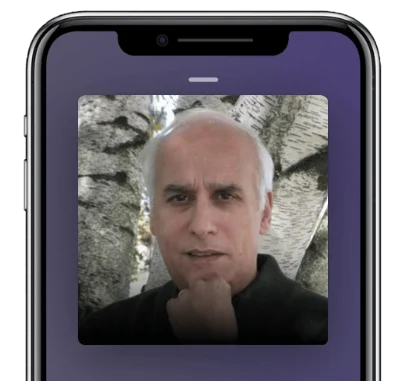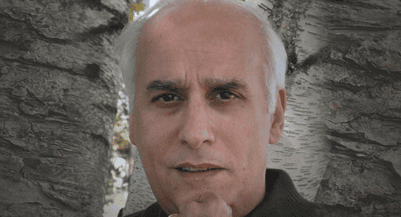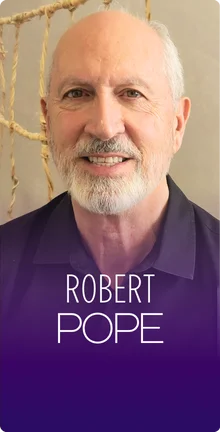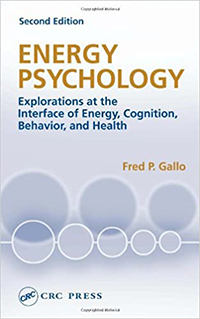
Welcome, Fred! It’s great to have you! I’m so grateful for the impact that you’ve had on my life.
It’s good to talk to you again, Stephan! It’s been a pleasure meeting you at the Tony Robbins events and keeping in contact with you.
Yeah, so let’s, first of all, talk just a bit about energy psychology and what that means because I’m guessing a lot of listeners won’t be familiar with that terminology?
Sure! Energy Psychology is a term that I coined sometime in the ’90s after I discovered the work of Roger Callahan-Dr. Roger Callahan. He developed a method he initially called The Callahan technique. I have studied many different approaches. I mean, I practice something called neuro-linguistic programming, which Tony Robbins also studied with John Grinder. I’ve studied with Grinder and Bandler too, and that was way back in the ’70s-late ’70s or early ’80s. I learned different approaches, and as a clinical psychologist, cognitive therapy, and so on, but around 1992, I find out about this Roger Callahan, and I thought it was the craziest thing in the world. He said that, in an article, he had talked about treating addiction, and what he said, “First of all, was that addiction is an addiction to a tranquilizer-something that makes you more tranquil,” and I thought, “Yeah, okay, I agree with that.”
What it does is, it impacts an energy system in the body, and I thought, “Well, yeah, emotion and energy-that make sense.” He said, “So, the solution is what you have the person do is tune into their addictive urges, and then you have them tap under their eyes and under their arms.” Well, when I read that, I thought, “Now, this is weird.” I mean, because I had treated people with addiction, but I never did something like that. Anyway, one day, it was about a month later, a woman had come in to see me that had an addiction to pain medications. She didn’t have a pain problem, but she just like the effects of opioids and while we were talking, I was asking her what was it about the opioids that she liked, and as she described it, you could see that she was, there’s an old term called “geeking.” Have you ever heard that term? It’s a little different than your “get yourself optimized.”
I know.
Geeking is just like you’re craving. It’s kind of a street term they used to use back then. Geeking is when you’re really desiring something so strong so she was what I would call “geeking” at the moment. You can see it in her face. I mean, just her facial expressions, a little shaking, and she said, “Oh, yeah.” I said, “You’re feeling it right now,” and she goes, “Oh yeah, it’s very strong.” I said, “If you gave that a rating from 0-10, what would you give it?” She said, “Oh, it’s definitely 10,” and so then I used something that I had traditionally trained in. It’s from cognitive therapy so it was a visual technique where, basically, what you do is you change what you tell yourself and your mind about the issue. She did that and she was able to bring the stress level down, the geeking down, but then I asked her to get it back and she was able to get it back.
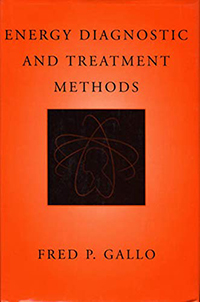
Then, it occurred to me, first of all, the fact that she could get it back didn’t seem that unusual to me because it was like, “Yeah, okay, that makes sense.” We sort of distracted her and she changed her thoughts, but then I remember this thing that Callahan had written about. Actually, I didn’t even remember what his name was but I said, “You know, I read this weird thing. Would you like to try this?” and I had her tap under her eyes and under her arm while she was thinking about the urge and fairly quickly the urge settle down. Now, the interesting thing was when I asked her to get it back, instead of getting it back up to 10, which she was able to do the previous time, this time she only was able to get it up to what she called a four, so it had been more than cut in half in terms of the urge. I had her do more tapping, we were ever bring it down again, but she would always come up to a four so I figured I needed to study more about this and find out more about it.
That’s when I reached out to Callahan. I spent time with him. I studied his method he later called the Thought Field Therapy, but then I became very obsessed about this whole thing. I started searching in his sources. I found out about something he had studied called applied kinesiology, which I had never heard of before, so I researched that, I studied that, and I reached out to some of the people that were really noted in that field like John Diamond and George Goodheart. I got in with John Diamond and all these different kinds of doctors. I spent time with Callahan, and I soon found out that this thing that he was doing while it was unique to him, there were other avenues that were in some way related, and I kept thinking, “What can we call this?” I have been invited to present this at Florida State University. I was teaching this tapping-I was going all over the country teaching in Canada.
I met a doctor there-Charles Figley. Dr. Charles Figley who was in charge of the trauma program. By the way, one of the things I found that you could really do with this tapping is, we can treat traumas very efficiently. If somebody had post-traumatic stress disorder, I got to the point with this method that I knew beyond any shadow of the doubt that when somebody walked in to see me with a condition like that, we could resolve it within the course, and most cases within the course of the session, and within the course of a few minutes of the session, which was phenomenal. I had never experienced anything like that before. Anyway, I’m presenting this there and later Figley got in touch with me because I’m looking at that method and several other methods. Maybe your listeners know the terms-eye movement desensitization and reprocessing or EMTR. I looked at that and something from NLP called visual kinesthetic dissociation. I looked at something else called traumatic incident reduction and this is thought field therapy, which is the name later that Callahan gave in.
I looked at all those methods and I thought, “What’s the commonality? What’s the common denominator? What accounts for all this?” I started looking at that and how did they all work. I started seeing these different patterns they were in. It’s just like in NLP and what they call modeling. I was doing that with the method itself. I told Figley about this and he asked me if I would write a journal article so I read a couple of journal articles. One day, I’m thinking that it’s about time I read a book on this and no sooner I’m thinking that, I got a call from Charles Figley asking me if I‘d like to write a book. Now, I didn’t have a publisher, but he happened to be on an editorial board of CRC Press so I wrote this book. Next thing you know, another publisher reached out to me-WW Norton-and they asked me if I would write a book. It just kept going on like that and I was going around.
However, back to the thing, when I wrote the first book, I was thinking, “What am I going to call this?” People were thinking, “You know, there are these therapies that work really efficiently.” They had given them a name like “power therapy” at first, which seems a bit kind of egotistical, but as Figley and I were talking, I knew I had written an article that I called, “Therapy by Energy” because I saw that one of the fundamental components of all these therapies was that there was something energetic going on. That whenever you had a problem-a psychological problem-that there was a blocked energy in the same way that the ancient Chinese talked about “qi” being blocked or stagnant, and tapping was a way of moving the energy. By moving the energy, it also caused the person to go back into a state of health, and here, we were just doing it with tapping.
Then, it occurred to me in the discussion with Figley-I don’t know how we exactly came to, but the name became “energy psychology” so I called it that. An association developed later called, The Association for Comprehensive Energy Psychology, and they used my name and they asked me if I would come and do a keynote and so I did that. It was just one thing after another. That’s what happened with energy psychology. Now, one of the people in the field that I was friends with was Gary Craig, whom I still know-Gary. Gary also studied with Callahan, and then Gary came up with this term “emotional freedom techniques,” which he acknowledged was also an energy psychology, and it was just a certain way of doing it. There’s a variety of ways of doing it.
Whenever you and I were in Zambia, what I did with you is, if you recall, I just did some muscle testing on you and then I figured out certain places where you should tap. Well, what I used with you was an advanced energy psychology method. It’s along the lines of the book I wrote, Energy Diagnostic and Treatment Methods, so there are variety of ways of doing this. They are very simple ways, and then sometimes, when simple ways don’t work, you have to have other ways of working. There’s a term in the field of cybernetics, which I’m sure you’re very familiar with, is called “requisite variety.” That means, basically, the more choices you have, the better chances are you going to be able to get a result so, I figured that if you just have one way to tap or one way to treat, that’s not going to work for everybody. The same thing applied in hypnosis. When I studied hypnosis way back, I was more interested in the approach of Milton Erickson-do you know that name?

Yup. I don’t know a lot about him though.
Yeah, Erickson had this way of doing hypnosis, which was very individualized as compared to having a standard routine that you use, and as a result, he could hypnotize everybody. The standard approaches only work with a certain number of people. Same thing with any therapeutic approach. It will work with a certain number of people and then after a while, there are certain times that it won’t work because the more you can individualize therapy, the better. Anyway, that’s a long-winded way of telling you something about energy psychology, but the basic idea of the energy psychology approach is, you have a kind of protocol where you tune in the particular problem, and you’re really tuning in the emotional components of it, even if it’s a limiting belief like when a person says, “I’m not good enough,” there’s an emotional charge around that.
If the person has a phobia, there’s obviously an emotional charge. If it’s trauma, they think of what happened and there’s emotional charge. You’re targeting that emotional charge, and one of the best ways to do that is to intervene in the body. It isn’t enough, very often, to just sit there and talk about it so, standard psychotherapy can be very useful, but it takes a lot longer to get things to move in a much healthier direction, I think. Whereas, with this, you just target right on the emotion. You have the person tapped at specific locations on the body, and they’re primarily acupuncture brilliant points, which is what we’re using.
A way that I’ve heard this described-maybe you’re the one who described it was that, you’re basically introducing entropy into the neural pathways. These neural pathways where you’ve experienced trauma and it’s just kind of replaying in your mind over and over again, especially when you get a stimulus that reminds you, or that you’re potentially going to be re-exposed to that thing that terrifies you like water if you’re afraid of water. I don’t swim, and I don’t know how to swim so that can trigger you, and then it’s like a well-worn groove or rut in your neural pathways, and by firing motor neurons-by tapping on these acupuncture meridian points, you’re adding entropy into the system, and it makes it fuzzier and less crisp like you’re they’re reliving the trauma. Is that a good description?
Yeah. To reiterate and just phrase it a bit differently. You have a pattern so, in your brain-not just your brain, but your body, but let’s say, it’s regulated by your brain-when you bring something to mind or you get triggered, there’s a certain activity going on in your brain and neurons firing in a certain pattern. While that’s happening, there’s stuff happening in the rest of your body. What you’re doing is, you bring it out online, and then while it’s online, by doing the tapping, you’re disrupting that structure, and you’re creating new neuron connections as a result of it. I mean, you can explain it in various ways, but it’s it changes the pattern. It changes the structure of the problem. The problem has a certain neurologic and a structure to it, which is not really hard-wired, it’s almost like-you could say it’s software, so you bring it on and you’re basically deleting and reprogramming, and it does it really efficiently.
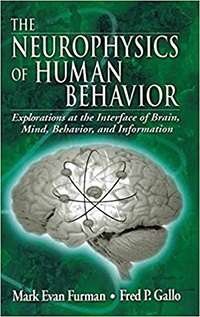
Right, and the places where you tap-like under the under the eyes or under the nose or I forget all the different points, but under the arms, the sternum-these are different places where you would tap, and if you’re in kind of an environment where it’s a little bit too weird for people to see you tapping all over your head and chest and everything, you can use your hand. Tap on your hand, right?
Yeah, you can do a variety things. First of all, the different places to tap. There’s a variety of places to tap depending upon the problem and depending upon the individual, but in places like the beginning of their eyebrows or the bridge of the nose-either side, okay? The side of the eye or down from the temple toward the eye or directly under the eye, under the nose, under the bottom lip, under a collar bone, either side, which is right next to the sternum but under the clavicle or about six inches under the armpit-each of these are different meridian points-and then on the fingers, there’s different points like the little fingernail, the middle fingernail, the index fingernail, the thumb, there’s a place on the back of the hand, there’s a place underneath on the rib cage, underneath the breasts.
They go by different names like the meridians-there’s the stomach meridian, there’s the bladder meridian, gall bladder meridian, central vessel, governing vessel, kidney meridian, and heart meridian. If you look at an acupuncture chart, you’ll see these different pathways, and there’s a number of different points. Well, certain ones have been found to be very useful. For example, under the eyes would be the first point on the stomach meridian, and that’s been found to be a very effective one. It was one of the first ones that Roger Callahan used in treating somebody who had a fear of water, and he successfully treated her within a matter of about a minute and a half. Those are places that you tap while the person attunes the particular issue.
Now, the thing is though, let’s say the person’s out in public-first of all, when I treat somebody, I’m treating them in such a way that they won’t necessarily have to treat themselves after that. If we do it thoroughly enough, it holds. It will really change things so that they don’t have that issue they’re going to have to deal with anymore, but problems can have many components to it, and so very often, I like to teach my clients how to tap in different ways. Once they get used to tapping, a very interesting thing happens. If they’re out in public and they just imagine tapping those points. If they just bring it to the mind, it works too.
Hmm. Wow!
Which is very, very cool. They’re in some situation where there’s a whole crowd there and they’re feeling anxious-now, all of a sudden, they imagine, let’s say we found the tapping under the eyes to really help them settle anxiety, and they imagine tapping into the eyes. They just bring their attention to that, and you can bring your attention to it like visually or even just kind of like bring your awareness to those locations, and it will start to stimulate. Now, how I found out about that is, one day a client comes in that I’ve been working with and he said, “If I’m feeling whatever things, I don’t even have to tap. If I just think about it, it works.”
Then, I said, “What do you mean if you just think about it? I mean, just think about what we did or what do you mean?” and he said, “No, I actually kind of like sort of picture in a way that I’m tapping those points and it works!” Then, I had another client come and spontaneously say that thing too so, I thought, “Well, I’m going to try that myself,” so I did it on myself on certain things, and I found that that worked for me as well. Generally, I tell clients after we’ve done this-I say, “If you’re in some situation, just imagine tapping.” There are other ways. You can just touch a point-like if you just put your finger on the point and take a breath, that’s also been found to be effective. Here’s a weird thing: If you had a doll, and you tap on those points on a doll, which I’ve had little kids do, that works as well.
Oh, wow!
Because while they’re tapping on the doll, they’re sort of attached to it in a way. They’re connected with it. They relate to it. It would be the same thing as like in a bus-let’s say somebody starts yawning in a bus and everybody else starts yawning, right? There’s that kind of thing that happened so, just tapping on adult, tapping on a picture, looking at a picture of somebody tapping at certain locations. When I’ve presented in workshops, where I’m having somebody tap up in front, and other people find that the issues that they’ve had resolved as they were watching us tap up on stage. They’re just sort of identifying with the person the speeds. There’s a variety of ways to do this sort of thing.
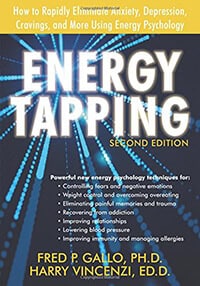
Right, and I can attest to the fact that the sticks.
Yeah.
It really does because after a 40-minute treatment with you, I was able to, the next day or couple days later, go shark-diving. That same day that we did the tapping exercise for 40 minutes, I went on the microlite, which is-
Oh, yeah! I remember that!
A hang glider, essentially, with a motor attached to it, and there was a pilot-
Yes.
And I was sitting in the back. I mean, I was still scared, but I was so proud of myself that I was able to do that. We went into the mist above Victoria Falls, and it got really bumpy. You couldn’t see anything, but I still managed to-
Did you do any tapping up there while you were going along?
No.
No, you didn’t? I should have probably had you do that.
Well, that is the choice. It was fine. I mean, it was a little white knuckle there for a little bit when we were bumping around inside the turbulence-
Oh my God.
Yeah, but it was okay. Then, three months later, after that time in Africa, I went inner tubing for the first time in my life. I did not know that I would be able to do it, but I’m like, “All right, let’s give this a go.” I didn’t skitter off into the lake. Thankfully, I was able to stay attached to the inner tube. I was holding on pretty tightly, but I went inner tubing being pulled by a speedboat for the first time ever, and that’s thanks to you and the tapping. Then, maybe two years later, I went jet-skiing for the first time. I never would have dreamed of doing that. Remember, I haven’t even gone kayaking or canoeing ever before in my life, and I went canoeing afterwards as well several years later. So, yeah, the sticks. It was 40 minutes, and I didn’t really do any more tapping after that. It just kind of stayed with me. Amazing!
Yeah. I remember-if I could say this-
Yeah, absolutely!
When we were in Zambia, I remember we were at this resort-I think it was in Zambia where we’re walking along-you and I were walking along from some sort of an event-and you said to me something like, “You know, Fred, I used to think that I was afraid of water, afraid of flying, and afraid of dying, and that just doesn’t seem to be true anymore. I don’t know what to believe about myself now.” You said something like that. I said, “Yeah. Interesting, isn’t it? I guess you’re going to have to have a different view of yourself.”
Well, it keeps changing too. Forever evolving. I have forgotten that we also worked on fear of death too.
Yeah, you were afraid of dying.
Yeah.
Yeah.
Amazing!
It’s funny.
And so, that forty minutes that we spent doing the tapping you did some things that were kind of unusual. I have seen other people do tapping. I’ve sent one of my daughters to go get tapping with a practitioner to deal with fear of flying, and that worked pretty well, but something about what you did was unusual and special like, you’d reversed something when you did these muscle test to see like, “Okay, so that didn’t really do it so, let’s do this reverse thing or something.” Do you know what I’m talking about?
Oh, yeah, yeah, yeah.
Can you walk us through this?
Well, of course. Each person is going to be a bit different, but here’s a basic kind of idea: You tune in a problem-so, you think about your fear of dogs, let’s just say. I’ll have you think about that, and then you feel, I say, “Well, when you think about that, how much does that bother you right now-right now, and at this moment?” Let’s say you’ll go, “Oh, Jesus! It’s a 10. I can just feel it. I feel tension. I feel my heart raising. I feel this anxiety.” I say, “Okay, good. Let’s do this,” and then if I’m going to use muscle testing so I’ll say, “Think about it,” and they’ll start feeling, and if I press on a muscle, let’s say I’ll have you extend your arm up, and we press on it, it should generally weaken because of the stress in the system.
Then, I’ll have you say something like this-I’ll have you say, “I want to get over this,” or “I want to quit being afraid of dogs,” and then I muscle test you again. If it’s congruent, the muscle will now test strong, but if it’s incongruent, you’ll test weak so, you go, “I want to quit being afraid of dogs,” we would expect that, in most cases, the muscle to now test strong if that’s what you truly, throughout your being, want both consciously and unconsciously. Do you follow me?
Each person is going to be a bit different, but here’s a basic kind of idea: You tune in a problem. Share on XMm-hmm. Yup!
Okay, so then, let’s say it tests weak though-so, now, I had you do something like this-now, there are varieties of these two, but I’m just going to say a simple one-I would have you tap on the side of your hand as if you’re karate-chopping, and I have you say something like, “Even though I’m afraid of dogs, I accept myself,” while you’re tapping there. After doing that, let’s say, three times, I test you again. I’ll have you say, “I want to get over this fear of dogs,” and if that works, your muscle will now test strong. Now, all the ducks are in order, okay? Now, we, then, do some tapping. I had you tap on, let’s say, I would think, in terms of fear of dogs more than likely the treatment with the woodwork would be I’ll have you tap under your arm and then under your collarbone.
Then, I’ll have you ran that a few times, and I’ll have you check to see what your stress level. If you’re on course, you will start to find that the stress goes from, maybe, a 10 to 5, and then we do it again, and then, maybe, it goes down to a three, and so it comes right down. Sometimes, I add another thing where I have you, maybe, I’ll have you do this-either I tap on the back of your hand between your little finger and ring finger or I have you do it or I have you do certain maneuvers. I have you close your eyes, open your eyes, look lower left, and look lower right as you follow my finger in a circle with your eyes, and then in the other direction, with your eyes, hum a few notes, count, hum a few notes, and then check again.
Yes, I remember that now.
Yeah. What I’m doing is, having you activate different areas of your brain and different areas of the energy system. We’re kind of like tuning it to see-we’re solidifying the results, and we’re also checking to see if there’s anything else there in the system that needs to be addressed. Then, maybe, I have to tap under your eyes, under your arms, and your collarbone again. However, let’s say I did something too, and we’re doing this tapping, and it’s not working that well-then, I’ll have you go back and I muscle-test you again, and I check your hemispheres. I have you put one hand off, one hemisphere, one hand off the other, and then I locate through this procedure that I developed-how to find a meridian point that will really work for you, and then we find it. It could be something odd.
It could, maybe, be somewhere off to the side of your chin or on the top of your head or the back of your head, depending upon what I find there, but I find it very efficiently. It doesn’t take forever to get to it. It’s very, very quick. It’s like I have an embedded flow chart that takes me to it, and I can teach anybody how to do that. We would do things like that, and now the stress is gone, let’s say, so once we’ve done our adjustments, whatever the stresses are, then I do another procedure. I want to say-can we build in a positive trajectory? If you take something-so, you take the structure or the pattern, and you break it apart so, you make it go into what you call an entropy-so, it has lost its structure. I don’t know though-could there be a little bit of that structure still there? Could it be there somewhere like a hologram that there might be some little component of it or a fractal that would reassemble the whole thing again? It’s like a seed that could grow again like, we didn’t cook all the seeds. To further support entropy, what I’ll have you do-I hope I’m not being too technical here-
No, no, no. By all means, keep going.
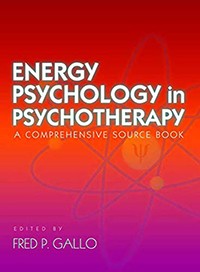
To make sure that you don’t go back into that pattern, and to give that pattern a chance to really go totally into entropy because we don’t want to give it energy any more. We want to take the trigger where you would usually go into this old pattern and create a different pattern. Okay, so now I have you, maybe, at the simplest level, I say-and we’re going about dogs-and I say, “How much do you believe that the next time you see a dog that you can pet a dog?” I mean, not a vicious dog, but you could pet it and you could feel comfortable around the dog. I’ll say, “Let’s reverse the scale. If 0 is you can’t do it all and 10 would be phenomenal and you could do it with no problem whatsoever, where would you put yourself? Then, you tell me, “Well, I don’t know. Maybe 3,” which tells me that believe it as much as you’d like for you to feel stable in the outcome.
Then, I checked that too with muscle-testing to see if that’s consistent with what you said verbally. I want to see if there’s an unconscious part that agrees with that too so, let’s say, we find us a 3, and then I’ll have you do something like this. I’ll have you tap the back of your hand between the little finger and ring finger, and I’ll have you start installing the belief. I’ll help you do it. There are different ways you can do this. You can just keep reaffirming, “I feel really comfortable around dogs. I really like dogs. I feel secure and actually feel enjoyment with dogs,” or you could picture yourself petting a dog and have an image of yourself doing that and being very comfortable. You could do that or you could just get in touch with what you think the feeling would be like if you had that kind of comfort while you’re doing this tapping and that starts to install that. We’re not only neutralizing the negative. You know the old song that goes, “You have to accentuate the positive-“
Yes.
So, we go from neutralizing the negative and then accentuating the positive side. The next time you see a dog, instead of going into a distress mode because, well, we’ve already taken that apart a lot, you also have more of a positive feeling about the dog so, we’ve installed the positive one. I’ve just described a lot of technicality involved in it, but those are some of the things, if that makes sense. Maybe if your listeners listen to that a few times, it will make more and more sense or maybe, I said it clearly enough.
No, that’s great, but there was something that was a reversing-maybe you had me move my eye patterns around counter-clockwise or something. I remember doing something clockwise and then you’re like, “Okay, that didn’t really work or stick or whatever so, let’s do this counter-clockwise,” and what was it that you had that was counter-clockwise?
You know, I’m not sure.
Is it my eye pattern or eye movement?
Well, here’s one of the things. I mean, whenever-maybe I was looking at this, but usually, now that the problem isn’t bothering them, it’s really their feeling fine, when you have them make their eyes go around in a circle, it’ll be very smooth whereas, other times, it can be a jerkiness, a saccadic movement, at certain points and the eyes moving, and so it could have been that. I mean, this is quite a few years ago so I don’t know exactly for sure what we did there, but if I see that the person’s eyes movements are smooth, that’s further confirmation that it’s handled because you’re not seeing the stress and that movement so that could have been what we’re doing. What I do standardly and doing what I call the “brain balancing procedure” or what Callahan called, The Nine Gamut Treatments. Part of that is you make your eyes go in a circle clockwise and then in a circle counterclockwise so we go both directions like that. I mean, there’s a lot more to discuss about that, but that’s, basically, one of the components of that technique.
Mm-hmm. When you’re working with a client and here she is in session, do you anticipate that that person is going to need further sessions in order for them to get the impact that they’re looking for or is one session typically enough?
It depends on the individual issue. If somebody came in and let’s say they had just been-well, here, I had somebody recently a case so she had a severe automobile accident. Some people crashed into her car, and the people in the other car were killed. She was stuck under the dashboard, and it took them a long time to get her out. They had to do something. They used the Jaws of Life to kind of rip the car apart to get her out of there, and then she had to be life-flighted in all this so, that was an instance, a single incident trauma, and she came in, it was a year later because she had to go through physical recovery and all that from the accident, and she still-when she thought about that accident, she was still having, well, spontaneously, she was having nightmares. She would have flashbacks on. She had what we call post-traumatic stress disorder, okay?
So I had her tune in to a specific aspect of that trauma at the first session that really bothered her, and the one that really bothered her first that she brought up was that, when she was stuck under the dashboard so we did tapping on that. Very interestingly, it only took about three minutes and that was neutralized. That didn’t bother her anymore. Well, there were still other aspects of that event that needed to be treated such as when she went to the hospital, to go through rehabilitation, that fact that the other people in the car died-just various-you can call them maybe “scenes.” If I had enough time in a session, maybe I would go through a whole bunch of scenes, but sometimes, that’s maybe too much for a person. In her case, because of all the trauma that she’d gone through there, she had turned to alcohol as a way of coping so in treating all of these issues with her, we had like a total of 10 sessions.
If somebody’s had a lot of trauma very early in life, in their childhood, they never really developed much resilience because of all the trauma.
There were other things to treat, but if you take that first session, that issue never ever bothered her again. I follow that up later. I used to, at times, call people years later and check on them to see what went on, did it last, or whatever. I always let them know to come back if it hasn’t, and we can definitely deal with it. If somebody’s had a lot of trauma very early in life, in their childhood, they never really developed much resilience because of all the trauma. They were, let’s say, sexually molested or whatever at that time-I’ve treated people like that too. That takes a lot longer though because you have to help them build in resources and so on. It isn’t like, if anybody tells you, “All you have to do is just tap, tap, tap and it doesn’t matter what the problem is, it’s cured in one session,” that’s not always true, and it wouldn’t be very responsible if I treated a person one session and then I didn’t have them come back.
I would say, “I would like to see you again to see how this is doing so, let me see you next week,” or “Let me see you in two weeks, and let’s see where that is and double-check on things.” There’s also another way-let’s say, you take a bigger issue. Let’s say a person has a belief about themselves that they are unlovable, okay? They carry this core belief that they’re just unlovable. Nobody will really love me. Now, how does somebody come to that? How does that happen? Well, a model that makes sense to me is that, there are specific events in that person’s life that lead them to that kind of generalization. They’re what we would call, “episodic memories,” specific memories that lead to this. They may not really be trauma. I mean, they could or could not be, but they’re events that lead to this, and they may have a series of them. There could be, in some instances, there’s one, and in others, there’s maybe 10, and so, those 10 memories, let’s say, those 10 kinds of events hold this belief about themselves in place-does that make sense?
Yup, that makes sense.
Okay, so it’s empirical. You go from the specific to the genera so, the specific events lead to the generalization, “I’m not lovable,” so then, we start taking those out. We just tune in one after another and not come out, and then after you do that, the generalization’s gone so then, they feel differently about themselves. You can’t talk a man to believing that they’re really worthwhile if they have this strong belief that has a strong emotional charge that goes, “I’m not lovable.” Anyway, that was a long-winded way of answering your question, but the right answer is-it depends. How involved is the person’s issue? What we’re doing is, we’re going after it. We know what we’re doing. We’re going after the site. As we talk, I find out where’s an intervening point? What’s something that holds that together? What’s the linchpin? There may be a bunch of linchpins so you treat those.
So, you had a major car accident. What therapy did you use to get past that? Did you use something that was kind of a precursor to this?
Well, in some ways, it’s an aspect of what I do now, but here’s what happened: I didn’t go for therapy. I know you mentioned there was therapy. I used to have panic attacks. After the accident, I would have these panic attacks that came out of the blue. I never even thought about it. I wasn’t a psychologist at the time. I got through college in philosophy degree and I took all of the psychology courses, but the way we thought of psychology back in 1968 is very different in the way I think about it now, and you’re not a psychologist because you get a bachelor’s degree. Anyway, here’s the thing: I had this accident, and after that, I would have generalized anxiety in general, and then I would have these panic attacks.
Whenever a panic attack happened, I would do what most people would do-you go around, you’re pacing around, and you’re trying to get rid of this thing. It’s like, “Oh my God, what’s going on?” I felt like I was going to die any second. To make the long story short, one day, after many, many panic attacks and I would ride them through at times, but in trying to get rid of them, this one day I had this panic attack that went on for over two hours, and I tried everything to get rid of it. I took a shower, I then took a cold shower, and I drank some lemonade. First of all, I’ve washed my face. I went around pacing and praying. I remember that I had some whiskey in the house, and I didn’t like whiskey, but I thought it maybe I take a shot of whiskey, and I did a shot of whiskey, and now, I still had a panic attack plus there’s this burning going on too.
Then, I thought, “Well, maybe if I run down the street,” and I ran down the street and I ran back. I ran about a quarter of a mile, and then a quarter of a mile back, and I got back to the house, but I’m still having a panic attack, and here’s where a weird thing had happened: I don’t know what possessed me to do it, but I went into the bedroom, I lied flat down the bed, and I said, “Get me. Go ahead and get me.” It was like, “I don’t care, go ahead.” Instantaneously, the panic attack was gone. I searched for it in my body. It’s kind of like, I’m doing a bit of a body scan trying to find it, and it was nowhere to be found. Then, I realized something that was just very obvious. That, what I have just done was the total opposite of what I’ve been trying to do before. Everything I was doing before was trying to get rid of it, and now, I was not trying to get rid of it. Actually, I was willing for it to even be worse. That viewpoint or that attitude and relationship to it could not support it being there anymore.
Wow! That reminds me of something I learned from the monks in India on a different Tony Robbins Platinum Partner trip. The Oneness monk said, “Let the tiger devour you.” Let’s say that you’re feeling fear, anxiety, or some sort of uncomfortable feeling or whatever-instead of running from it, instead of trying to dissipate it or push it down or repress it, let the tiger devour you. Just let it engulf you-that feeling-and then just go away.
What I have just done was the total opposite of what I’ve been trying to do before. Everything I was doing before was trying to get rid of it, and now, I was not trying to get rid of it.
Yeah. Well, that would be the same thing I did, but here is a second realization I have right then, okay? Besides that-realizing that by really going into it and even wanting it to be worse, like you’re saying-“letting the tiger devour you,” I realize the second thing that I could not do that is a way of trying to get rid of the panic attack. Now, here, let me clarify, if I did that, that technique of going into it, as a technique to try to get rid of the panic attack, that attitude would be the same thing as trying to get away from it.
Ah.
You see?
Yup.
I realized I had to be authentic. It had to be for real. It had to be really-“Go ahead, kill me. Go ahead!” and not with, in the back of my mind thinking, “Oh, this is sneaky. I’m going to manipulate it,” because you would know! You would know that you’re not being for real. It had to be truly, truly being-maybe the terms we would use now are: mindful, mindfulness, non-judgmental about it, not thinking of it as bad-really willing to go into it and letting it be there. Then, somehow, healing occurs on the same terms. It doesn’t occur because you are going to manipulate it into it. Anyway, that was sort of the thing that I realized in that moment. From then on, I didn’t have panic attacks. Although I do recall, there were two instances where I started to go into a panic attack again, and that started happening, and I just really went into it again.
I remember it like the one was a couple of weeks after that event. The effect of the panic attacks started, and I and I realized something that I hadn’t realized before-that I would get one feeling, and then I would go into the panic. It was an odd feeling in my body, first of all. Almost like this buzzing molecules disintegrating-I don’t know what you want to call it. It was almost like, “Beam me up, Scottie!” kind of thing where the molecules all get dissipated and then they get reassembled up in the ship, but it felt kind of like that if I think about it. That started, and immediately, I went into it.
Wow.
With the intention of really going into it. I’m going to really go into this thing. It was like, “Yay, here we go!” Immediately, that dissipated and it never became a panic attack. It’s really interesting. It was really exciting. It was just a feeling-just a very different feeling that I was able to embrace, but anyway, here’s one of the things that I’ve discovered. I have a term I use now. It’s called, “mindful energy psychology,” and it’s thiI’ve come to realize over the years that when somebody does the energy psychology techniques of tapping whether it’s EFT or TFT or my EDxTM or whatever, if you’re doing that and your attitude is the therapist and the clients or operator or whatever you want to call yourself, and the client is one of, “I have to get rid of this thing,” that will interfere with the effectiveness of the method. That, truly, to do it in a thorough way, you should be absolutely non-judgmental, mindful, and really willing to observe it. Let it be there, and then notice what happens as the tappings are going on without any kind of an axe to grind about it.
Right, so no agenda.
No agenda. If you do that, then you’re more focused on the specific of what you’re feeling and what you’re experiencing rather than also this other thing that’s going on where I got to get rid of it. You’d have too many, and it’s not clearly focused on what you’re aiming for, which is just simply to observe while you’re tapping and see what happens. It’s kind of like a discovery. When you do it that way, I find that healing occurs.
Mm-hmm. Do you ever use tapping on yourself? You’re using all the time when you’re walking your clients through it on a daily basis, right?
Oh, yeah. Although, over the years, because I started doing this around 1992 so, there are few years under my belt with this, right? As I’ve done it more and more-the different issues that I’ve done it on don’t really come up to get me anymore, but still, nobody gets to the point where they’ve filled away all the layers of the onion so, at times, something comes up, and that’s another, “Oh, yeah! There’s that to deal with your life, you know?” I try to, mostly, just by observing and embracing, but then at times, I add tapping to it. I find that’s very helpful for physical things too. I used to have migraines, and I tapping regularly on migraines way back and that would have been in the mid-’90s or something, and I don’t get migraines. I’ve just resolved them. I had a lady recently that had shingles. She has this chronic shingles. Do you know what shingles are?
Yup.
They’re really painful. She came in one day-she wasn’t coming in to see me because who would go and see a psychologist about shingles? I mean, not to thinking you can get rid of them. You figure you have to be on certain medication or whatever-
Right.
She had this chronic shingles. They would come and they would dissipate, and the next thing you know, and maybe a few times a year, she would get the shingles. She came in, and she had the shingles, and she was getting ready going to vacation. One of the techniques I used that I do, but different protocols I’ve developed-one of them I call it, excuse me if it sounds egotistical, but I call, “The Gallo Method” and “The Gallo Process.” I use one of those two terms, but it has elements of mindfulness and there’s a bit of “Tonglen”-I don’t know if you know what that is.
No, I don’t.
It’s a meditative process, and I include tapping so I had her focus on the shingle pain, and I took her through this process, and just a few rounds of doing this, the pain was gone. Then, we went on with regular things in the session where we were really dealing with her relationship issue or whatever she had come about. Then, she said at the end of the session, “You know, the pain hasn’t come back. I don’t know that I need any pain medication. I was going to call my doctor about pain medication,” and I said, “Well, look, I’m not making any promises. I’ve never done that for this so, why don’t you still call your doctor and get some pain medication anyway just in case you need it because you’re going to be gone and you’re going to be on vacation.” I saw her two weeks later, and she said, “You know, the pain never came back,” and a very interesting thing, she says is, “Within two days, the eruptions were gone,” and I said, “Well, you were on Valtrex at the time, aren’t you?” and she goes, “Well, yeah, but I always went on Valtrex, but it’s never cleared up this quickly, and the pain didn’t come back,” so I kept checking on her at times. A year-and-a-half later, I kept checking. My last check on her was a year-and-a-half after that, and she had not have a recurrence of shingles, which, I don’t know, there’s an end of one.
Wow.
But it was, at least in her case, it was very effective. I found and other people who found tapping, whether it’s EFT tapping or TFT tapping or the approaches I use, that they’ve been effective for different physical conditions as well. With physical pain, here’s kind of like an interesting pointer: When you have physical pain, it’s not going to only be the organic part-let’s just say it’s something organic, but you have emotional factors involved in the pain, so you hate the pain or you feel embarrassed about the pain or you feel afraid about the pain or whatever-if you target the emotional component of it, and tapping works very well to move that. Okay, so it moves that through because emotions should only be-you know, they get activated then they pass, right? Well, you get kind of stuck with an emotion, and what tapping does is, it lose that emotion through, and so you’re not stuck with it. Anyway, you take out the emotional components involved, the pain, and the physical pain itself dissipates.

Wow!
So, you can always there’s that aspect to it.
Yeah, for me, that really resonates. I have this pain in my left index finger and it’s gotten progressively worse over the last few years. I had an MRI scan on my finger thinking that maybe it’s a glomus tumor or something, but nope-theirs is nothing wrong structurally with my finger, but it’s very sensitive so I’m super careful not to bump it against anything, even gently will just be like taking a hammer to my finger-it would feel like that. There’s a lot of emotional content related to that like, “Oh my God, is this like the canary in a coal mine? Is there something horrifically wrong with my nervous system or something? This really resonates with me like takeaway that emotional content, but in a way that you don’t run from it. You have to let the tiger devour you.
Right.
Do the process, yeah.
Yeah, so, let’s say you do this. Do you have any pain there right now?
If I touch it, yeah.
Okay, so if you touch it on a scale of 0-10, how much pain?
Seven.
A seven. Now, you go, if you did this, I don’t know if this will work, but would you want to try something so your listeners hear that?
Sure!
Okay, tap the side of your hand-the little finger side of your hand-and while you’re tapping there, just say, “Even though I have this pain in my index finger, I accept myself.”
Even though I have this pain in my index finger, I accept myself.
Okay, now say it this way: Say, “I accept myself with this pain in my index finger.”
I accept myself with this pain in my index finger.
Say it one more time.
I accept myself with this pain in my index finger.
Now, tap directly under your nose and say, “Even if this pain in my finger continues forever, I accept myself.”
Even if this pain in my finger continues forever, I accept myself.
I accept myself with this pain in my finger continuing forever.
I accept myself with this pain in my finger continuing forever.
Okay, so now, tap between your little finger and your ring finger on the back of your hand while you keep your focus on the index finger. You just steadily tap between little finger and ring finger on the back of the hand.
Okay.
And just be willing to observe the feeling without any intention of doing anything but observe it. Okay, notice how it feels when you touch it. Notice the feeling. How would you describe this sensation for one?
Okay, so I should go ahead and touch it again?
Yeah, go ahead and touch it while you’re tapping.
Okay.
How would you describe the sensation?
It’s dissipated a bit, but there’s still the pain there. Just when I bumped against it is when I’ll have this severe pain so-
Okay, but feel the pain. Notice what the pain is though-I mean, how would you describe the pain rather than calling it pain?
A sharp, sort of nerve sensitivity that gets triggered just brushing against it or bumping against that part of my finger near the side.
So, it’s short of sharp?
Yeah.
Anything like hot or cold?
I guess kind of-yeah, maybe a little hot.
Little hot and sharp, okay. Like, pinching sharp?
No, more like a throbbing sharp.
Like a throbbing sharp. So, notice that throbbing sharp-
Yeah.
While you’re tapping the back of your hand-
Okay.
Notice anything you feel about it emotionally.
Mm-hmm, yup. Fear, anxiety-
Yeah, yeah. Notice that. The fear, the anxiety, and while you’re tapping the back of the hand points, say: “Even though I have this fear and this anxiety about my finger, I accept myself.”
Even though I have this fear and anxiety about my finger, I accept myself.
Even though I have this fear and anxiety about my finger, I accept myself.
Even though I have this fear and anxiety about my finger, I accept myself.
Okay. You just keep observing it. Now, go ahead and touch it again, see what it’s like.
It’s less.
What would you give it now, number-wise?
Well, the same amount of pressure and touching it, it’s maybe a three.
A three. Now, keep the pressure there and keep tapping the back of the hand good. And, again, say, “Even though I have this fear and anxiety about my finger-“
Even though I have this fear and anxiety about my finger-
“I accept myself.”
I accept myself.
I accept myself with worrying about my finger.
I accept myself with this worry about my finger.
Okay, now, notice it again. How does it feel now?
I’ll say it’s about a two.
Two. Now, if you keep doing some of that, you could possibly eliminate all of the stress related to it, and then maybe it’s emotion that just continues to stimulate that.
Yeah, like a memory that is feeding the pain that’s kind of like a phantom pain.
Yeah, yeah, yeah. Anyway, that gives you a little pointer on it.
Yeah. Well, thank you!
You’re welcome.
That’s great! Well, let’s wrap up the episode here.
Yeah, okay.
How can people take the next step if this resonates with them, they want to try tapping-maybe on their own, or they want to find a therapist? What would you recommend like for kind of doing it themselves? Is there a particular YouTube video that you would recommend-maybe one that you’d produce? If they want to find a therapist, is there a particular website that they would go to?
Okay, let me give you a few things-so, if they want to read a book or anything like that, that would help them, assuming people are not professional therapists or whatever-even professional therapists would find these useful-My books, Energy Tapping and Energy Tapping for Trauma, can be useful. For Energy Tapping, the only way you can get that at this point is through Kindle whereas, Energy Tapping for Trauma is still on paperback. They can get it either way.
Got it.
Another thing is, you could go to my website: www.energypsych.com. Now, if you go to the site, you can find information about seminars, you can go to YouTube, check if there are any videos by Gary Craig or Dawson Church. I don’t have any specific ones there in how to train people. Some people, if they want a treatment, and I do some treatment consultation education over Skype or telephone. You can also contact my office at (724) 346-3838. I’m doing a seminar in Germany, in Northern Germany, in September. It’s listed under the seminars tab. You could locate me there. I just got done doing a seminar in Santa Clara and I did one up in Toronto so, if you check my website at times, you’ll be able to see where I am, what I’m doing, or read some books. Anybody who wants specific training, even feel free to drop me a line at fg****@*********ch.com or fr*********@***il.com, and I’ll get back to you. It’s been a pleasure talking with you all. Pleasure talking with you, Stephan.
Okay, thank you, Fred! Thank you, listeners! I’m your host, Stephan Spencer, signing off!
Important Links
Connect with Fred Gallo
Organization
Books
Videos


